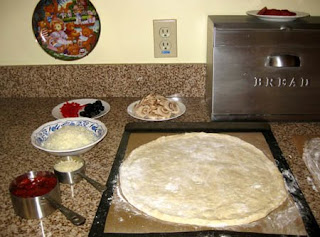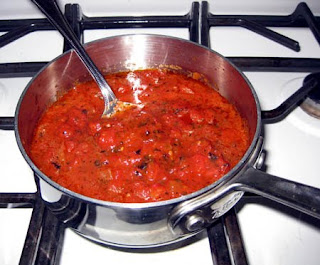
Years ago I took a long series of cake decorating lessons and spent many hours converting my cake, frosting and filling recipes (I don't "do" mixes) to work with all the various sized pans I might be using for different numbers of people. I had all the equipment one would need to make all sorts of beautiful cakes for any occasion, including weddings. I am so over all that! Sure, I'll still do a fancy cake once in a while, if I happen to get in the mood. Usually, I just make a layer cake (homemade, of course) frosted and filled with a buttery icing and maybe do a simple piped border.
But for days when even that is too much effort ... there's always my quick and easy feeds-a-crowd lemon sheet cake that is served right from the pan--perfect for any large casual party. The only special equipment required is an 18x13x1-inch half-sheet pan.
It is quite a flat cake, dense and velvety, and can be cut into about seven or eight dozen 1 1/2-inch squares as a quick and easy stand-in for petits fours (I don't make those anymore either!) at your next large tea party.
But for days when even that is too much effort ... there's always my quick and easy feeds-a-crowd lemon sheet cake that is served right from the pan--perfect for any large casual party. The only special equipment required is an 18x13x1-inch half-sheet pan.
It is quite a flat cake, dense and velvety, and can be cut into about seven or eight dozen 1 1/2-inch squares as a quick and easy stand-in for petits fours (I don't make those anymore either!) at your next large tea party.
Don't forget to Pin it and share it!
Meyer Lemon Sheet Cake
(Makes 18x13x1-inch half-sheet, 32 servings)The Cake
4 large eggs
1 1/3 cups buttermilk, divided
1 1/2 teaspoons vanilla extract
2 1/2 dip-and-sweep cups (12.5 ounces/354 grams) unbleached all-purpose flour
1 3/4 cups (12.25 ounces/347 grams) sugar
4 teaspoons baking powder
3/4 teaspoon salt
1 3/4 sticks (7 ounces/198 grams) unsalted butter, room temperature
Finely grated zest of 3 Meyer lemons
The Frosting
6 tablespoons (3 ounces/85 grams) unsalted butter, room temperature
3 cups (12 ounces/340 grams) confectioner's sugar
1/16 teaspoon salt
1 teaspoon vanilla extract
3 tablespoons fresh Meyer lemon juice
1 Preheat oven to 350F/180C/Gas4. Spray an 18x13x1-inch half-sheet pan with cooking spray; don’t try to make-do with a smaller pan, or the batter will overflow.
2 In medium bowl, lightly combine the eggs, 1/3 cup of the buttermilk and the vanilla.
3 In large mixing bowl, combine flour, sugar, baking powder and salt; with electric mixer on low speed, mix for 1 minute to blend (it rather takes the place of sifting). Add the softened butter and remaining buttermilk. Mix on low speed until combined. Mix on medium-high speed for 1 1/2 minutes. Beat in the egg mixture in three batches, beating for 20 seconds after each addition. Stir in the lemon zest by hand; otherwise, the zest gets all tangled up in the beaters.
(I often use this two-stage mixing method I first learned about from The Cake Bible by Rose Levy Beranbaum.)
4 Pour into prepared pan. Bake for about 25 to 30 minutes, or until toothpick inserted in center comes out clean. Cool slightly on wire rack, about 15 minutes, before frosting. While the cake is cooling just a bit, make the frosting.
5 In large mixing bowl, beat softened butter. Gradually beat in confectioner's sugar, then salt, vanilla and lemon juice. With offset spatula, apply thinly to the slightly cooled cake. It will melt a bit into a smooth, shiny glaze. Let cool thoroughly, 3 to 4 hours, before serving.
The Frosting
6 tablespoons (3 ounces/85 grams) unsalted butter, room temperature
3 cups (12 ounces/340 grams) confectioner's sugar
1/16 teaspoon salt
1 teaspoon vanilla extract
3 tablespoons fresh Meyer lemon juice
1 Preheat oven to 350F/180C/Gas4. Spray an 18x13x1-inch half-sheet pan with cooking spray; don’t try to make-do with a smaller pan, or the batter will overflow.
2 In medium bowl, lightly combine the eggs, 1/3 cup of the buttermilk and the vanilla.
3 In large mixing bowl, combine flour, sugar, baking powder and salt; with electric mixer on low speed, mix for 1 minute to blend (it rather takes the place of sifting). Add the softened butter and remaining buttermilk. Mix on low speed until combined. Mix on medium-high speed for 1 1/2 minutes. Beat in the egg mixture in three batches, beating for 20 seconds after each addition. Stir in the lemon zest by hand; otherwise, the zest gets all tangled up in the beaters.
(I often use this two-stage mixing method I first learned about from The Cake Bible by Rose Levy Beranbaum.)
4 Pour into prepared pan. Bake for about 25 to 30 minutes, or until toothpick inserted in center comes out clean. Cool slightly on wire rack, about 15 minutes, before frosting. While the cake is cooling just a bit, make the frosting.
5 In large mixing bowl, beat softened butter. Gradually beat in confectioner's sugar, then salt, vanilla and lemon juice. With offset spatula, apply thinly to the slightly cooled cake. It will melt a bit into a smooth, shiny glaze. Let cool thoroughly, 3 to 4 hours, before serving.
Disclosure: We are a participant in the Amazon Services LLC Associates Program, an affiliate advertising program designed to provide a means for us to earn fees by linking to Amazon .com and affiliated sites. We are a ThermoWorks affiliate, earning a small commission at no cost to you on purchases made through our links. This helps cover some of the costs of running the blog. Thank you for your support.
Jean












